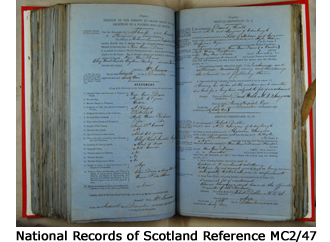One of the things I love about being a genealogist is that every day is different, you can never know exactly what you’ll find. I was looking through some Dumfries Sheriff Court processes the other day (on the hunt for ‘paternity’ cases) and came across a case innocuously entitled Jones v Lochmaben. As this bundle of folded papers tied up with string was larger than the others and appeared to contain some sort of notebook I untied the string to have a nose inside.
This lengthy case was regarding the ‘Nuisances Removal (Scotland) Act 1856’. It would seem that far from being the picturesque holiday destination that it is today, back in 1866 Lochmaben had a big problem with dung, pigsties and general filth.
Amongst the items was a large document entitled: “Report of list of Nuisances in the Burgh of Lochmaben on 6th and 7th November 1866”.
Within are contained the names and addresses of 182 households, detailing the condition of the property. I found this item fascinating, it tells us so much about the town that after reading a few entries you could almost smell the place!
Here are some excerpts:
No. - 140
Date of Inspection - 7th [November 1866]
Name and Occupation of Occupants of Premises - Ebenezer Brown Hill, Free Church Manse
Description of Nuisance - An accumulation of dung and filthy stagnant water and very dirty yard.
Remarks - [In pencil] None*
No. - 141
Date of Inspection - 7th [November 1866]
Name and Occupation of Occupants of Premises - John Clark, Schoolmaster
Description of Nuisance - A necessary* containing in and about it a great accumulation of filthy matter.
Remarks - [In pencil] None
No. - 167
Date of Inspection - 7th [November 1866]
Name and Occupation of Occupants of Premises - Robert Thorburn, Labourer.
Description of Nuisance - One Pigsty containing one Swine and an accumulation of Dung at Back of House.
Remarks - [In pencil] Nuisance
No. - 176
Date of Inspection - 7th [November 1866]
Name and Occupation of Occupants of Premises - John Green, Carter
Description of Nuisance - A House unfit for Human Habitation Occupied by Green. Having only one small apartment and his Family consists of Himself, Wife and 7 children. The House is Thatched on roof and they Occupy one Small apartment in which there is 3 Beds and where they all live both night and day. No ventilation. Bad House.
Remarks - [In pencil] Nuisance.
No. - 178
Date of Inspection - 7th [November 1866]
Name and Occupation of Occupants of Premises -Barnard Kelly, Hugh McGauchie, William Helon
Description of Nuisance - All keep Lodginghouses with no Rules and Regulations formed for their Guidance and Conduct.
Remarks - [Blank]
 |
| The dusty documents make your hands quite dirty! |
I hope I am not alone in being fascinated by this document and as we continue our research in the Sheriff Court records of Scotland I hope to come across more wonderful accounts like these.
If you are researching your Lochmaben forebears and see an entry relating to your family please get in touch and I will email you the full account relating to them.
*We presume the ‘necessary’ was the toilet… it’s mentioned as a ‘necessary’ quite frequently.
*The remarks in pencil we believe to have been added at a later date, perhaps on a subsequent inspection.





